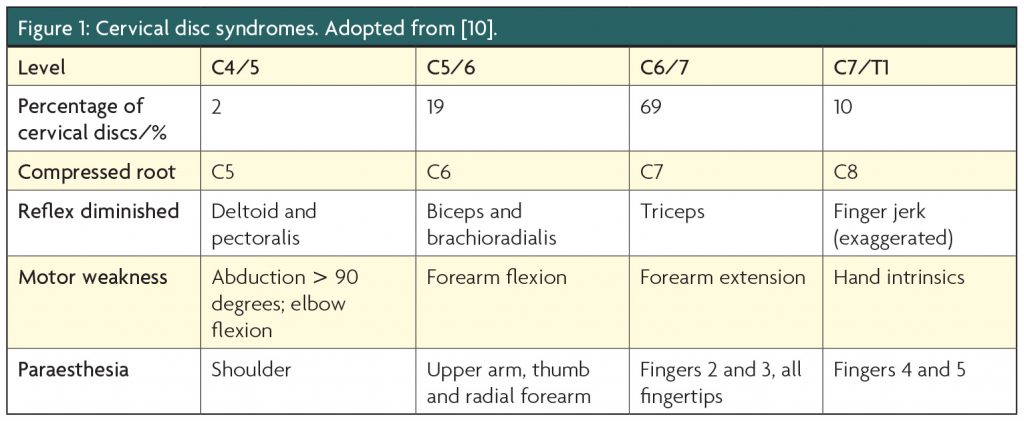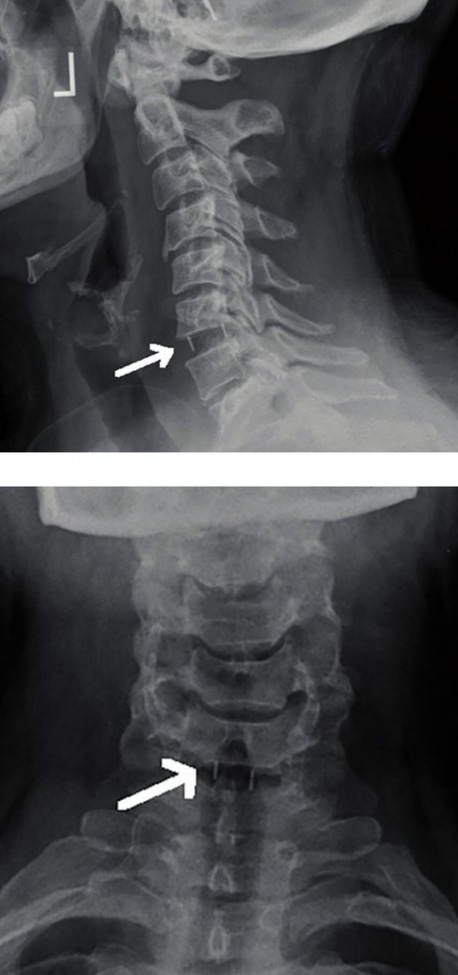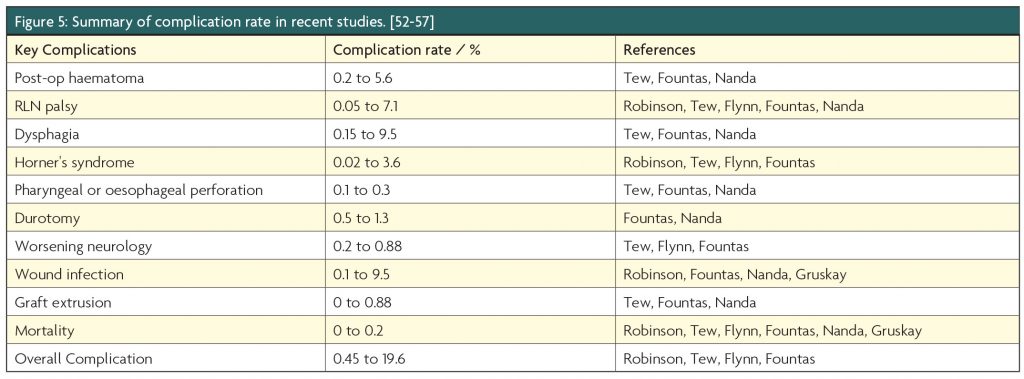Abstract
Anterior cervical discectomy and fusion (ACDF) has been used to treat degenerative cervical spine diseases for almost six decades. In this literature review, we have summarised the history, indications, outcome and complications of the procedure. We also provide technical details on surgery. Despite the emerging new technical advances such as cervical arthroplasty, evidence continues to support the use of ACDF, given its well-established safety profile and effectiveness.
Introduction
Anterior cervical discectomy and fusion (ACDF) has been one of the most commonly performed procedures for degenerative spinal diseases, with more than five million operations conducted in the United States between 1990 and 1999.1 The main indications are for the treatment of cervical myelopathy and radiculopathy secondary to cervical disc prolapse and osteophyte compression. It has also been used to treat a range of other cervical diseases (mainly between C3 and T1 vertebrae) related to cervical instability (degenerative, traumatic, oncological, infectious, inflammatory, iatrogenic).2
History of the procedure
Prior to 1950, cervical spine surgery was primarily performed via a posterior approach.3 The anterior cervical approach was initially described in the 1950s to access the oesophagus.4 In 1958, Smith and Robinson5 applied the approach to cervical discectomy and interbody fusion using a horseshoe-shaped graft, harvested from the iliac crest in 14 patients suffering radiculopathy. Degenerative changes had been demonstrated by myelography and discography. In this approach, the disc was removed and the space was filled by bone graft to achieve fusion. Posterior osteophytes were not removed and the posterior longitudinal ligament (PLL) was left intact. This indirectly decompressed the nerve root by distraction. Nine patients had an excellent outcome and four had good or fair results. In the same year, Cloward3 independently reported inter-body arthrodesis using dowel-type graft harvested from the iliac crest. In addition, Cloward’s approach also removed osteophytes, leaving the PLL intact. The majority of the 47 cases (all of which had neck, shoulder and/or upper arm pain) reported complete relief. Other types of grafting e.g. the onlay graft developed by Bailey and Badgley6 and the keystone graft developed by Simmons and Bhalla7 have not been widely adopted.
Diagnosis
Neck and shoulder pain is a common complaint in primary care, hence careful selection is required to identify patients with pathology that warrants ACDF. The age-adjusted incidence of cervical radiculopathy is 83 per 100,000 persons (less common than lumbar radiculopathy), with potential risk factors including female gender, white race, cigarette smoking, axial load bearing, and prior lumbar radiculopathy.8
A recent literature review9 found no high-quality study that had measured the incidence or prevalence of cervical spondylotic myelopathy but the prevalence of surgically treated cervical spondylotic myelopathy was estimated as 1.6 per 100,000 persons.
Radiculopathy
As each nerve root exits above the pedicle of its like-numbered vertebra, a herniated disc usually impinges on the nerve root exiting from the neural foramen at the level of herniation (e.g. C4/C5 disc herniation tends to affect root C5). A summary of cervical disc syndromes is given in Figure 1.10 Root compression usually causes dermatomal or myotomal pain, paraesthesia or numbness and a range of lower motor neuron (LMN) signs including muscle atrophy, fasciculations, weakness in a specified myotome, reduced re exes, as well as sensory changes in a dermatomal distribution.

A few clinical tests have been described to aid diagnosis. Axial loading of the head while tilting the head towards the symptomatic side may reproduce the radicular symptoms (Spurling’s sign); whereas axial traction may alleviate them. Symptoms may also be relieved by shoulder abduction in a sitting patient. These clinical tests tend to be highly specific but not very sensitive.11
Myelopathy
Myelopathy may be acute or chronic; complete or incomplete. There may or may not be a history of acute trauma. Degenerative cervical myelopathy (DCM), defined as symptomatic myelopathy associated with degenerative arthropathic changes in the spine axis is a leading cause of acquired spinal cord compromise.12 Commonly there are signs of upper motor neuron (UMN) compromise – weakness with spasticity, as well as brisk reflexes and ankle clonus. In addition, loss of sensation below level of involvement and autonomic dysfunction may be evident. Other signs include Lhermitte’s sign (an electric shock-like sensation in the neck on flexion of the neck), a positive Hoffmann’s reflex, Babinski’s sign and scissoring gait in some patients. Central cord syndrome is associated with certain types of injuries such as neck hyperextension, often in a patient with pre-existing osteophytes encroaching upon the spinal canal.
Diagnosis is usually supported by the use of magnetic resonance imaging (MRI) unless contraindicated. In addition to sagittal and axial views, parasagittal oblique views can be used to visualise neural foramina perpendicular to the plane of root exit (Figure 2). This enhances the sensitivity of MRI for the detection of small disc prolapses encroaching upon the exiting nerve root. If MRI is contra-indicated, computed tomography (CT) and/or CT myelogram are used. Electrophysiological studies are performed only when there is diagnostic uncertainty.

An early study in 196313 followed 51 patients with cervical radiculopathy over two to 19 years. In this cohort, no patient with radicular pain progressed to have myelopathy. In a survey14 of over 500 radiculopathic patients with a median duration of follow-up of 4.9 years, recurrence of the condition occurred in 31.7%, and 26% underwent surgery for cervical radiculopathy. Radicular pain and focal neurology were predictors for operation. In a cohort study of 26 consecutive patients with radiculopathy followed up over 1 year, over 90% of patients improved without surgery;15 operative management is therefore reserved for patients with intractable pain or progressive neurology.16 In the case of myelopathy, there are no large randomised trials on which to base treatment recommendations but for patients with more severe myelopathy, progressing deficits or acute deterioration, surgical decompression is recommended.17-19 Surgery to prevent neurological injury in patients with asymptomatic cervical spondylotic disease is not recommended as risk of minor trauma causing deterioration is very low.20
Operative technique
The technique used for ACDF varies widely among surgeons. We outline our routine technique.
Positioning
The patient is positioned supine with a vacuum horseshoe-shaped sandbag placed in the nape of the neck, supporting the head bilaterally. Position is neutral, and horizontal. Slight head-up, or even head-down tilt may be used to facilitate visualisation of a specific disc space.
Skin incisions and platysma division
A 4cm transverse skin crease incision is made at the appropriate level. Anatomical land-marks are used to identify the correct level e.g. thyroid cartilage at the level of C4 and cricoid cartilage at C6. Pre-incision fluoroscopy is used by some surgeons to confirm the level of the approach. The skin incision extends medially from the anterior border of right sternocleido-mastoid muscle (SCM) (mainly for the ease of right-handed surgeon). The platysma is exposed and then divided along the direction of the muscle fibres (although some prefer dividing the platysma transversely).
Surgical plane and discectomy
The anterior triangle is then dissected, developing a plane between carotid sheath laterally and the larynx and oesophagus medially, as shown in Figure 3.


The carotid pulse should be confidently identified using a gloved finger inside the wound. The midline structures are retracted en bloc to avoid retraction on the recurrent laryngeal nerve (RLN). An avascular plane is dissected down to the longus colli muscles, which are then undercut bilaterally using diathermy and a periosteal elevator. Toothed self-retaining retractors are inserted under the longus colli fibres to provide a clear surgical view. Fluoroscopy is always used at this stage to confirm the operating level. Any anterior osteophytes may be removed using electrical drill or Kerrison punch. Caspar pins are used to distract adjacent levels. Discectomy is performed using a size 15 scalpel, straight microrongeurs and microcurettes under the operating microscope. Posterior osteophytes and the posterior aspect of the uncus are removed with the high speed drill, currettes and micro upcuts. The senior author recommends use of a match-head drill to perform this manoeuvre. The posterior longitudinal ligament (PLL) is carefully opened, away from the site of maximal neural compression. This is facilitated with a size 10 Rhoton hook and an upcurved Karlin blade. The ligament is resected using a 1mm upcut to enable good visualisation of the dura and the nerve root origins. A 2mm upcut is sometimes used at this stage. A 16 Rhoton hook is useful to probe the exiting foramen.
Graft
A PEEK cage packed with bone chips/dust obtained from removal of osteophytes is widely used as graft material for interbody fusion. The cage may be straight or incorporate a 5 degree angulation to correct kyphotic deformity. A number of grafts have been used to promote fusion. Autologous bone grafts are preferred to promote osteogenesis, osteoinduction and osteoconduction;21 these are usually acquired locally from osteophytes. In order to reduce donor site (traditionally iliac crest, bula or rib) morbidities,22 such as pain, infection and haematoma, a number of substitutes such as allogenic bone graft and synthetics have been developed. There are also other options including ceramics23 and more controversially, bone morphogenic proteins (BMP).24 In addition, cages are generally made of plastics e.g. polyetheretherketone (PEEK)25 or metal e.g. titanium.26 Carbon fibre cages27 have also shown promising fusion rates.
Plate vs. no plate
There is currently no consensus in the option of anterior plates in ACDF. Our centre does not routinely use anterior cervical plates when performing a 1 or 2 level ACDF. A recent randomised trial28 indicated that multiple-level fusions may have better clinical outcome when a dynamic plate design is used but the use of a plate in single-level ACDF remains controversial. Plating in anterior cervical operation was initially developed for cervical spinal trauma such as fractures and dislocations.21 For the treatment of cervical spondylosis, it may confer the theoretical benefit of additional stability, maintenance of cervical lordosis and prevention of extrusion of bone graft material. A number of plating and fixation device designs29 have been developed – dynamic plate, locking screws to promote stability and alignment, and to reduce risk of visceral damages. A zero-profile system fixing the cage onto vertebral body with screws has shown comparable clinical outcomes and fusion rates relative to using anterior cervical plating, and is reported to have reduced risk of dysphagia or degenerative change of adjacent segment.21 More recently, bioabsorbable plates appear to achieve fusion rate and outcome comparable to the results associated with metallic plates.30
Post-operative care

a) (top image) Lateral.
b) (bottom image) Antero-posterior.
The white arrows denote position of the graft.
Post-operatively, it is imperative to monitor the patient’s airway and neurological function with clear documentation. A rapidly developing wound haematoma can threaten airway patency and may require immediate evacuation. Any impairment of neurological function warrants an MRI scan to assess the cause and guide treatment options. Some surgeons request a post-operative cervical X-ray to confirm operative level, cage position and the position of any plating system (Figure 4). This rarely changes clinical management and is of doubtful clinical value.
Measured outcomes
With cervical myelopathy, 50 to 80% of patients are reported to improve after surgery, while 5 to 30% continue to report ongoing or progressive symptoms.31-33 Positive prognostic factors in improving the patient-identified clinical outcome (as defined by modified Japanese Orthopedic Association scale) were younger age, shorter duration of symptoms, non-smoking status, and lack of significant gait impairment.34
Factors reported to predict a poor response to surgery include older age, intramedullary signal abnormality on MRI, especially if multi-segmental and with abnormalities on T1 as well as T2-weighted images, more severe preoperative disability, longer duration of symptoms preoperatively, narrow preoperative canal size and multisegmental compression.17
The surgical outcome for cervical radiculopathy is more equivocal. Randomised controlled trials showed that it provides short term benefit in terms of pain and neurological deficit relative to conservative treatment but by one to two years, there was no significant difference in outcome.35,36 Therefore conservative management was recommended by the authors as the initial modality of treatment.
Alternative treatments
Non-surgical options generally involve pain management and physiotherapy. Of note, a 10-year prospective randomised study37 involving 64 patients showed no significant benefit with surgical treatment for mild to moderate cervical myelopathy. Neuroprotective treatments such as riluzole, a sodium-glutamate antagonist are also being trialled at the moment.38
The main anterior surgical alternatives to ACDF in the treatment of degenerative cervical diseases include anterior corpectomy and anterior discectomy without fusion. Posterior decompression (with or without fusion) via a limited exposure and foraminotomy (for root compression), a laminectomy or laminoplasty (for cord compression) remain options, particularly when the compression is posterior.
In terms of surgical treatment, there is no consensus regarding the indications and timing. Also it is not known which type of surgical procedure is best as Class I randomised trials are lacking.17 The anterior approach has the theoretical benefit of removing any compressive disc material and anterior osteophytes, as well as facilitating fusion of adjacent vertebral bodies directly. Posterior cervical pathology may be better treated with posterior approaches. Minimally invasive posterior decompression has been shown to be as effective as ACDF in selected patients with myelopathy.39
The use of an implant to act as a spacer for fusion has become increasingly common, but a prospective, randomised trial40 suggested that even though the incidence of fusion was indeed higher, patient satisfaction and rate of return to preoperative activity level were similar regardless of an ACD or ACDF. Another trial41 showed that posterior cervical foraminotomy, ACDF and anterior cervical discectomy without fusion are equally successful in treating cervical radiculopathy caused by a unilateral acute herniated cervical disc.
ACDF vs cervical arthroplasty
The use of an artificial joint instead of fusion to retain mobility at the level of operation has long been proposed. A metal-on-metal, ball-in-socket Cummins-Bristol design reported outcomes in 1998.42 Not only does it have the potential to provide a better range of movement but it also theoretically reduces motion and pressure at adjacent segment43 and hence incidence of adjacent segment disease (ASD). Nonetheless, a number of complications such as screw pullout had been reported and surgical removal of the hardware proved to be considerably difficult.42 A range of new designs and materials have been developed. Examples include the second-generation Bristol design (also known as Prestige®) which replaced the inferior hemispherical cup of the Cummins design with a shallow ellipsoid saucer to allow for more movement, and they have shown promising results in the trials.23,44 Another design known as the Bryan® disc adopted a metal-on-plastic model and also showed hopeful preliminary results.44,45 The literature has however not shown arthroplasty conferring significant long-term advantage: a Cochrane review46 with 2400 participants showed a small but statistically significant favourable outcome for arthroplasty compared to ACDF but it was withdrawn due to non-compliance with the Cochrane Commercial Sponsorship Policy.47 Another systemic review48 suggested no superiority of cervical total disc replacement relative to fusion operation. Another meta-analysis,49 showed that arthroplasty does not reduce the rate of ASD compared to ACDF. More studies are required to confirm its efficacy and safety.
Complications
Factors associated with increased operative risk have included: increasing age, medical co-morbidity (American Society of Anesthesiology (ASA) class > 2), chronic obstructive pulmonary disease, bleeding disorder, coexisting diabetes mellitus, OPLL and longer operative duration.50,51 A large retrospective study also suggested that the male gender increased the risk of airway complications.51
Complications of ACD (with or without fusion) can be classified as:
1) general complications e.g. anaesthetic risks, infection and haemorrhage;
2) access-related complications e.g. oesophageal, neurovascular and tracheal damage;
3) discectomy- and fusion-related device-related risks e.g. damage to nerve root or spinal cord and loosening of screws;
4) risks of non-union, compressive residual disease and ASD.
A summary of complication rate from various recent studies is shown in Figure 5.52-57

There is insufficient evidence to support differences in rates of complications across surgical techniques.58 A retrospective American study59 with 36000 patients found an overall complication rate of 15.6% after ACDF, 29.2% after posterior fusion, 41.1% after combined anterior and posterior fusion, and 22.4% after laminoplasty. The author acknowledged that the rates are considerably higher than other similar studies and attributed the discrepancy to their accurate data sourced from commercial claims, outpatient services and Medicare databases, reducing the risk of losing follow-up outcomes.
However, different techniques are often associated with different types of complications:60 for example, 1) dysphagia is more frequent following anterior surgery, 2) wound infection is more common following posterior surgery, and 3) higher rates of axial pain are observed following laminoplasty compared to ACDF.
Dysphagia and dysphonia
Dysphagia and dysphonia are both common complications after ACDF. They are likely to be multifactorial such as secondary to visceral oedema or neuropraxia of RLN or superior laryngeal nerve secondary to retraction. The majority (67 to 100%) of patients with vocal cord palsy recover within 12 months and most recover within 6 to 12 weeks.61 It is imperative the surgeon is aware of the anatomy (e.g. the RLN is located in the tracheoesophageal recess) during traction. Due to the increased risk of dysphonia from the anterior approach, professional speakers and singers need to be counselled with care.
Equipment-related
With respect to locking plate-related complications, a retrospective study involving 2000 patients62 estimated a 10.7% complication rate, including loosening or breaking of the plates and screws or malpositions that threatened tracheoesophageal or neurovascular structures. These were radiologically diagnosed and only a small number required re-operation. In addition, plating appears to increase the risk of adjacent level ossification (ALO), the clinical significance of which is debatable.63
Conclusions
Six decades after the procedure of ACDF was first used to treat degenerative spine diseases, the literature has supported its position as the mainstay of treatment for a number of cervical spinal pathologies. It is an established, safe and effective procedure, with an acceptable complication profile. A variety of techniques have been adopted and in this article we have outlined the indications and technique we routinely use in our centre. Some issues remain controversial – such as the use of plating and arthroplasty, and require further studies.
References
- Angevine PD, Arons RR, McCormick PC. National and regional rates and variation of cervical discectomy with and without anterior fusion, 1990-1999. Spine (Phila Pa 1976) 2003;28(9):931-9; discussion 940. https://doi.org/10.1097/01.BRS.0000058880.89444.A9
- Eck J, Vaccaro A. Surgical Atlas of Spinal Operations. 2013: Jaypee Brothers Medical Publishers.
- Cloward RB. The anterior approach for removal of ruptured cervical disks. J Neurosurg, 1958;15(6):602-17. https://doi.org/10.3171/jns.1958.15.6.0602
- Lahey FH, Warren KW. Esophageal diverticula. Surg Gynecol Obstet. 1954;98(1):1-28.
- Smith GW, Robinson RA. The treatment of certain cervical-spine disorders by anterior removal of the intervertebral disc and interbody fusion. J Bone Joint Surg Am. 1958;40- A(3):607-24. https://doi.org/10.2106/00004623-195840030-00009
- Bailey RW, Badgley CE. Stabilization of the cervical spine by anterior fusion. J Bone Joint Surg Am. 1960;42-A:565-94. https://doi.org/10.2106/00004623-196042040-00001
- Simmons EH, Bhalla SK. Anterior cervical discectomy and fusion. A clinical and biomechan- ical study with eight-year follow-up. J Bone Joint Surg Br. 1969;51(2):225-37. https://doi.org/10.1302/0301-620X.51B2.225
- Corey DL, Comeau D. Cervical radiculopathy. Med Clin North Am. 2014;98(4):791-9, xii. https://doi.org/10.1016/j.mcna.2014.04.001
- Boogaarts HD, Bartels RH. Prevalence of cervical spondylotic myelopathy. Eur Spine J. 2015;24 Suppl 2:139-41. https://doi.org/10.1007/s00586-013-2781-x
- Greenberg MS, Greenberg MS. Handbook of neurosurgery. 7th ed. 2010; Tampa, Fla. New York, N.Y.: Thieme Medical Publishers. xiv;1337.
- Viikari-Juntura, E, Porras M, Laasonen EM. Validity of clinical tests in the diagnosis of root compression in cervical disc disease. (Phila Pa 1976), 1989;14(3):253-7. https://doi.org/10.1097/00007632-198903000-00003
- Kato S, Fehlings M. Degenerative cervical myelopathy. Curr Rev Musculoskelet Med. 2016;9(3):263-71. https://doi.org/10.1007/s12178-016-9348-5
- Lees F, Turner JW. Natural History and Prognosis of Cervical Spondylosis. Br Med J. 1963;2(5373):1607-10.
https://doi.org/10.1136/bmj.2.5373.1607 - Radhakrishnan K et al. Epidemiology of cervical radiculopathy. A population-based study from Rochester, Minnesota, 1976 through 1990. Brain.1994;117 ( Pt 2):325-35. https://doi.org/10.1093/brain/117.2.325
- Saal JS, Saal JA, Yurth EF. Nonoperative management of herniated cervical intervertebral disc with radiculopathy. Spine (Phila Pa 1976). 1996;21(16):1877-83. https://doi.org/10.1097/00007632-199608150-00008
- Galbraith JG et al. Operative outcomes for cervical myelopathy and radiculopathy. Adv Orthop. 2012;2012:919153. https://doi.org/10.1155/2012/919153
- Levin K. Cervical spondylotic myelopathy. UpToDate 2013 [cited 2016 1/6].
- McCormick WE, Steinmetz MP, Benzel EC. Cervical spondylotic myelopathy: make the difficult diagnosis, then refer for surgery. Cleve Clin J Med, 2003;70(10):899-904. https://doi.org/10.3949/ccjm.70.10.899
- Robinson J, Kothari MJ. Treatment of cervical radiculopathy. 2016 [1/6/2016].
- Bednarik J et al. Are subjects with spondylotic cervical cord encroachment at increased risk of cervical spinal cord injury after minor trauma? J Neurol Neurosurg Psychiatry. 2011;82(7):779-81. https://doi.org/10.1136/jnnp.2009.198945
- Song KJ, Choi BY. Current concepts of anterior cervical discectomy and fusion: a review of literature. Asian Spine J, 2014;3(4):531-9. https://doi.org/10.4184/asj.2014.8.4.531
- Silber JS et al. Donor site morbidity after anterior iliac crest bone harvest for single-level ante- rior cervical discectomy and fusion. Spine (Phila Pa 1976). 2003;28(2):134-9. https://doi.org/10.1097/00007632-200301150-00008
- Suetsuna F et al. Anterior cervical fusion using porous hydroxyapatite ceramics for cervical disc herniation. a two-year follow-up. Spine J, 2001;1(5): 348-57. https://doi.org/10.1016/S1529-9430(01)00057-2
- Carragee EJ, Hurwitz EL, Weiner BK. A critical review of recombinant human bone morpho- genetic protein-2 trials in spinal surgery: emerging safety concerns and lessons learned. Spine J. 2011;11(6):471-91. https://doi.org/10.1016/j.spinee.2011.04.023
- Celik SE, Kara A, Celik S. A comparison of changes over time in cervical foraminal height after tricortical iliac graft or polyetheretherketone cage placement following anterior discec- tomy. J Neurosurg Spine. 2007;6(1):10-6. https://doi.org/10.3171/spi.2007.6.1.3
- Whitecloud TS. 3rd, Modern alternatives and techniques for one-level discectomy and fusion. Clin Orthop Relat Res. 1999;(359):67-76. https://doi.org/10.1097/00003086-199902000-00008
- Marotta N et al. Five-year outcome of stand-alone fusion using carbon cages in cervical disc arthrosis. Eur Spine J. 2011;20 Suppl 1:S8-12. https://doi.org/10.1007/s00586-011-1747-0
- Nunley PD et al. Choice of plate may affect outcomes for single versus multilevel ACDF: results of a prospective randomized single-blind trial. Spine J. 2009;9(2):121-7. https://doi.org/10.1016/j.spinee.2007.11.009
- Haid RW et al. The Cervical Spine Study Group anterior cervical plate nomenclature. Neurosurg Focus. 2002;12(1):E15. https://doi.org/10.3171/foc.2002.12.1.16
- Tomasino A. et al. Bioabsorbable instrumentation for single-level cervical degenerative disc disease: a radiological and clinical outcome study. J Neurosurg Spine. 2009;11(5):529-37. https://doi.org/10.3171/2009.6.SPINE08838
- Chiles BW 3rd et al. Cervical spondylotic myelopathy: patterns of neurological de cit and recovery after anterior cervical decompression. Neurosurgery. 1999;44(4):762-9; discussion 769-70.
- Ebersold MJ, Pare MC, Quast LM, Surgical treatment for cervical spondylitic myelopathy. J Neurosurg. 1995;82(5):745-51. https://doi.org/10.3171/jns.1995.82.5.0745
- Lunsford LD, Bissonette DJ, Zorub DS. Anterior surgery for cervical disc disease. Part 2: Treatment of cervical spondylotic myelopathy in 32 cases. J Neurosurg. 1980;53(1):12-9. https://doi.org/10.3171/jns.1980.53.1.0012
- Tetreault L et al. Predicting the minimum clinically important difference in patients under- going surgery for the treatment of degenerative cervical myelopathy. Neurosurg Focus. 2016;40(6):E14. https://doi.org/10.3171/2016.3.FOCUS1665
- Peolsson A. et al. Physical function outcome in cervical radiculopathy patients after phys- iotherapy alone compared with anterior surgery followed by physiotherapy: a prospective randomized study with a 2-year follow-up. Spine (Phila Pa 1976), 2013;38(4):300-7. https://doi.org/10.1097/BRS.0b013e31826d2cbb
- Persson LC et al. Cervical radiculopathy: pain, muscle weakness and sensory loss in patients with cervical radiculopathy treated with surgery, physiotherapy or cervical collar. A prospec- tive, controlled study. Eur Spine J. 1997;6(4):256-66. https://doi.org/10.1007/BF01322448
- Kadanka Z et al. Cervical spondylotic myelopathy: conservative versus surgical treatment after 10 years. Eur Spine J. 2011;20(9):1533-8. https://doi.org/10.1007/s00586-011-1811-9
- Fehlings MG et al. Rationale, design and critical end points for the Riluzole in Acute Spinal Cord Injury Study (RISCIS): a randomized, double-blinded, placebo-controlled parallel multi- center trial. Spinal Cord. 2016;54(1):8-15. https://doi.org/10.1038/sc.2015.95
- Abbas SF et al. A comparison of minimally invasive posterior cervical decompression and open anterior cervical decompression and instrumented fusion in the surgical management of degenerative cervical myelopathy. Neurosurg Focus. 2016;40(6):E7. https://doi.org/10.3171/2016.3.FOCUS1650
- Dowd GC, Wirth FP. Anterior cervical discectomy: is fusion necessary? J Neurosurg. 1999;90(1 Suppl):8-12. https://doi.org/10.3171/spi.1999.90.1.0008
- Wirth FP et al. Cervical discectomy. A prospective analysis of three operative techniques. Surg Neurol. 2000;53(4):340-6;discussion 346-8. https://doi.org/10.1016/S0090-3019(00)00201-9
- Cummins BH, Robertson JT, Gill SS. Surgical experience with an implanted arti cial cervical joint. J Neurosurg. 1998;88(6):943-8. https://doi.org/10.3171/jns.1998.88.6.0943
- Wig eld C et al. In uence of an arti cial cervical joint compared with fusion on adja- cent-level motion in the treatment of degenerative cervical disc disease. J Neurosurg. 2002;96(1 Suppl):17-21. https://doi.org/10.3171/spi.2002.96.1.0017
- Mummaneni PV et al. Cervical arti cial disc replacement versus fusion in the cervical spine: a systematic review comparing long-term follow-up results from two FDA trials. Evid Based Spine Care J. 2012;3(S1):59-66. https://doi.org/10.1055/s-0031-1298610
- Gof n J et al. Intermediate follow-up after treatment of degenerative disc disease with the Bryan Cervical Disc Prosthesis: single-level and bi-level. Spine (Phila Pa 1976), 2003;28(24):2673-8. https://doi.org/10.1097/01.BRS.0000099392.90849.AA
- Boselie TF et al. Arthroplasty versus fusion in single-level cervical degenerative disc disease: a Cochrane review. Spine (Phila Pa 1976), 2013;38(17):E1096-107. https://doi.org/10.1097/BRS.0b013e3182994a32
- Boselie TF et al. WITHDRAWN: Arthroplasty versus fusion in single-level cervical degenera- tive disc disease. Cochrane Database Syst Rev, 2015(5): p. CD009173. https://doi.org/10.1002/14651858.CD012339
- Zechmeister I, Winkler R, Mad P. Arti cial total disc replacement versus fusion for the cervical spine: a systematic review. Eur Spine J. 2011;20(2):177-84. https://doi.org/10.1007/s00586-010-1583-7
- Verma K et al. Rate of adjacent segment disease in cervical disc arthroplasty versus single-level fusion: meta-analysis of prospective studies. Spine (Phila Pa 1976). 2013;38(26):2253-7. https://doi.org/10.1097/BRS.0000000000000052
- Tetreault L et al. Clinical and Surgical Predictors of Complications Following Surgery for the Treatment of Cervical Spondylotic Myelopathy: Results From the Multicenter, Prospective AOSpine International Study of 479 Patients. 2015.
- Lim S et al. Predictors for Airway Complications Following Single- and Multi-level Anterior Cervical Discectomy and Fusion. Spine (Phila Pa 1976). 2016.
- Flynn TB. Neurologic complications of anterior cervical interbody fusion. Spine (Phila Pa 1976). 1982;7(6):536-9.
https://doi.org/10.1097/00007632-198211000-00004 - Fountas KN et al. Anterior cervical discectomy and fusion associated complications. Spine (Phila Pa 1976) 2007;32(21):2310-7. https://doi.org/10.1097/BRS.0b013e318154c57e
- Gruskay JA et al. Factors Affecting Length of Stay and Complications After Elective Anterior Cervical Discectomy and Fusion: A Study of 2164 Patients From The American College of Surgeons National Surgical Quality Improvement Project Database (ACS NSQIP). Clin Spine Surg. 2016;29(1):E34-42. https://doi.org/10.1097/BSD.0000000000000080
- Nanda A. et al. Surgical complications of anterior cervical diskectomy and fusion for cervical degenerative disk disease: a single surgeon’s experience of 1,576 patients. World Neurosurg. 2014;82(6):1380-7. https://doi.org/10.1016/j.wneu.2013.09.022
- Riley LH Jr et al. The results of anterior interbody fusion of the cervical spine. Review of ninety-three consecutive cases. J Neurosurg. 1969;30(2):127-33. https://doi.org/10.3171/jns.1969.30.2.0127
- Tew JM Jr, May eld FH, Complications of surgery of the anterior cervical spine. Clin Neurosurg. 1976;23:424-34.
https://doi.org/10.1093/neurosurgery/23.CN_suppl_1.424 - Fehlings MG et al. Introduction: Degenerative cervical myelopathy: diagnostic, assessment, and management strategies, surgical complications, and outcome prediction. Neurosurg Focus. 2016;40(6):E1. https://doi.org/10.3171/2016.3.FOCUS16111
- Veeravagu A et al. Surgical outcomes of cervical spondy- lotic myelopathy: an analysis of a national, administrative, longitudinal database. Neurosurg Focus. 2016;40(6):E11.
https://doi.org/10.3171/2016.3.FOCUS1669 - Tetreault L et al. A systematic review of clinical and surgical predictors of complications following surgery for degenerative cervical myelopathy. J Neurosurg Spine. 2016;24(1):77-99. https://doi.org/10.3171/2015.3.SPINE14971
- An HS, Jenis LG. Complications of Spine Surgery: Treatment and Prevention. 2006, Philadelphia: Lippincott Williams & Wilkins.
- Ning X et al. Anterior cervical locking plate-related compli- cations; prevention and treatment recommendations. Int Orthop, 2008;32(5):649-55. https://doi.org/10.1007/s00264-007-0369-y
- Park JB, Cho YS, Riew KD. Development of adjacent-level ossi cation in patients with an anterior cervical plate. J Bone Joint Surg Am. 2005;87(3):558-63. https://doi.org/10.2106/00004623-200503000-00012
- Brennan PA, Mahadevan V, Evans BT. Clinical head and neck anatomy for surgeons. 2015: CRC Press. xix, 338 pages https://doi.org/10.1201/b19589

